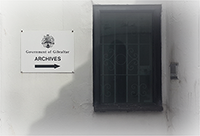
References to the state of Government Records at Gibraltar go back one hundred years.
A Royal Commission on Public Records in the United Kingdom, appointed in 1914 extended
its attention to the preservation of official documents in the Colonies and Protectorates.
The fear was then expressed that documents of great historical value would succumb to the
ravages of insects and climate. In response to a circular from Downing Street,
the Governor of Gibraltar, Lieutenant-General H.G. Miles,
was re-assuring – the records of the Supreme Court were kept in a properly ventilated strong room,
those of the Crown Lands (dating back to 1819 when the Commissioner for settling
Titles to Lands granted the present titles to Properties) were in charge of the Government Engineer
and kept in wooden cupboards in the Crown Land Office, whilst all other Colonial Official records,
old and recent were kept on shelves adapted to the purpose, in the record rooms of the Colonial Secretary’s office.
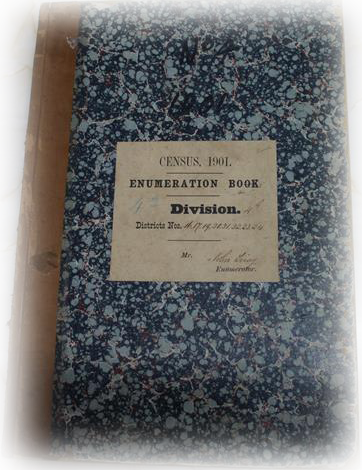
However, the Government Engineer of the time, J.R. Crook, was not so uncritical!
There was no strong room for storing the Crown Lands Records. He also suggested that the War Department,
who held pre-1819 records of great interest, should be asked to hand over all records not strictly of military value.
He also referred to other records held in various departments and not in fireproof buildings.
Detailed proposals for improvement by the Government Engineer came to nothing,
and the matter was allowed to rest for the next fourteen years.
In January, 1929, Downing Street again raised the matter, asking for information in regard to the records
of the Government in Gibraltar under the following heads:
- General condition
- Bound or unbound
- Whether registers or other summaries had been kept
- Whether the records were housed collectively or otherwise and in what type of building
- Whether the Record Offices were (i) fireproof; (ii) weatherproof; and (iii) insect-proof
The suggestion was then made that, if local conditions were unsuitable for the proper preservation of records,
these should be removed to the Mother Country.
The Governor of Gibraltar, Alexander J. Godley, re-assured the Secretary of State that the records in Gibraltar
were in good condition. Copies of deeds relating to lands, deposited in the Supreme Court in accordance with local law,
were bound annually, while the records of actions and proceedings in the court were placed between cardboards and
properly labelled. All material was indexed.
These records were housed in a strong room built of stone and cement fitted with iron shelving and iron window frames, bars and shutters.
The room was secured with an iron safe door and, after office hours, the iron shutters were closed.
The room was weather-proof and considered fire-proof. The records had not suffered in any way the ravages of insects.

One of few examples were deterioration had occured
The general condition of the records of the Public Works and Crown Lands department was good.
Titles to properties were bound between two pieces of cardboard and placed in cedar wood boxes stored in steel fire-proof cupboards.
Precis of Deeds relating to Lands, Building Applications and Correspondence were similarly protected,
and registers of all records were kept. The entire collection was housed in a fire-proof, weather-proof room,
and the records had not suffered in any way from the ravages of insects.
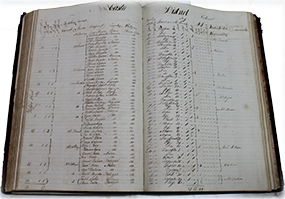
All other official record, old and recent, were kept on shelves adapted to the purpose in the Colonial Secretary’s Office.
A proportion of the older records and bound registers were kept of all records. Since all records were in good condition,
the Governor did not consider it necessary to remove any of them to the Public Record Office in London
to ensure their preservation.
In October, 1936, the Secretary of State issued a circular despatch on the subject of the destruction of out-of –date documents.
Concern was expressed that in some territories the procedure for such action was not very clearly defined, and that although
in the majority of territories the destruction of records required the authority of the Governor or the Colonial Secretary,
it appeared that in some cases only a general approval was required, and that details of documents to be destroyed were not
always submitted to the authority in question. Colonial Governments were reminded of the importance of taking steps to ensure
that when consideration was being given to the elimination of out-of-date records, careful regard should be had, not only
to their official utility but to their actual or potential historic interest as well. The destruction of records should therefore
require the approval of some responsible authority to which details of the documents to be destroyed should
first be submitted.

Earlier circulars on the subject of preservation of records were underlined with the interesting statement that:
‘The preservation of its records in a satisfactory state must be regarded as one of the first duties of a Colonial Government,
a duty which derives greater urgency from the fact that delay in the institution of suitable protective measures may and
does lead to the inevitable loss of documents of value.’ Once again, the alternative of transferring documents to the
Public Record Office was mentioned.
The two primary needs remained unsatisfied:
- The provision of suitable accomodation where the required conditions as to temperature
and lack of dampness could be met, and where all documents could be kept together.
- The appointment of a qualified archivist to sort out the documents with a view to destroying
what was worthless and preserving what was of value, and indexing the latter to
make them available for the purposes of research.
Top
The political events of the early 1960’s in the shape of renewed Spanish pressure for the return of Gibraltar highlighted the importance and value of these hitherto forgotten and abandoned documents.
Material relating to the Neutral Ground, jurisdiction within the definition of Gibraltar waters, etc.
were suddenly required in the preparation of Gibraltar’s case to be presented at the United Nations.
The task could not be carried out effectively, given the chaotic state of the papers.!
In January, 1966, Gibraltar’s Council of Ministers, considering future staffing arrangements at the
Gibraltar Museum, suggested that any appointee to the post of Curator might be required to act as
archivist as well. By June, the matter of finding suitable accomodation for the records was again
under consideration, and efforts were being made to sort out the ‘Special Files’ at Alameda House
and other old papers at the Naval Hospital Hill store.
It was then left to Dr. Howes, who arrived in Gibraltar in July, 1967, to study the matter and
make recommendations to the Government. He suggested that earnest consideration should be given to making a
start on the examination and conservation of the documents as soon as possible for two reasons:
- Because they might yield material of vital importance to Gibraltar politically.
- Because of their inherent historical interest and value.
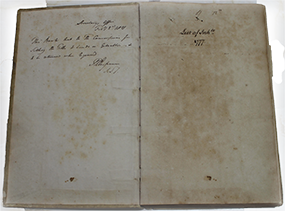
He made the following recommendations:
- The period to be covered should be from the earliest times to 1920
(records from 1921 onwards were kept in the Secrtariat and were already fully indexed.
- The volume of records in existence should be assessed, and centralisation of them should be considered.
- Adequate storage space should be found.
- Preliminary sorting should be carried out and a register prepared of available records suitable for preservation.
- The considerable quantity of loose papers should be sorted out by dates.
- Once the preliminary sorting had been completed and a reigister compiled,
a more detailed examination should be carried out with the object of preparing a detailed index.
During the course of this examination loose papers, already sorted by dates, should as far as possible be further
sorted by subject-matter and collected into files. Letters recorded in letter books should be
indexed and cross-referenced as necessary.
- The installation of air conditioning equipment.
- The provision of fireproof safes for the most important records.
- The application of preservatives against humidity and moulds.
- The provision of steel shelving.
- The provision of metal containers.
In September, 1968, the possibility of the of the museum curator taking on responsibilty for the records was raised again.
It was suggested that the Museum Committee ‘and such volutary helpers as may be able to recruit
(e.g. from the Gibraltar Society and perhaps some teachers)’ might set to work on the task.
There followed a report by D.C. Devenish, Curator/Archivist of the Gibraltar Museum.
Once again the recommendation was made that adequate space for the storage of the archives
ought to be provided: a large floor area of over 1,000 square feet was suggested.
Regarding the material itself, once more the need for sorting, indexing and cataloguing was stressed.
One new area of work for any potential archivist introduced at this stage was ‘helping students and answering enquiries.’
There was a departure from earlier comments concerning staffing.
“It is obvious that the work involved is far too much for part time or voluntary work.
It is clearly a full time job for one, or preferably, more than one person permanently.
A further interesting comment followed: “There seems no good reason why archives should come under the Museum.”
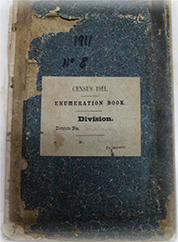
On further development, it was also suggested that the
archives might in time also house an adequate reference library.
The Permanent Secretary’s observations on the Devenish Report were that:
- The position was not as bad as it sounded in that much of the material alluded to was available
in the Commonwealth office records and in the Public Record Office, although there were still
“a lot of things to be done before we can be in any way satisfied that we are
doing all that we should to preserve and store our archives.
- The Curator of the Museum could not be expected to take on the archives as well
- The Commonwealth Office might be asked to send someone to Gibraltar to look at the problem
on the spot and advise as to what should be done.
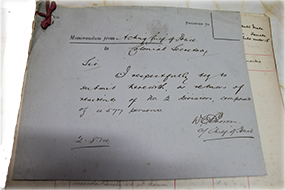
It was subsequently decided that the idea of bringing someone to Gibraltar to advise should be deferred
until at least some progress had been made in sorting out the material available, particularly that stored at Naval Hospital Hill.
At the beginning of 1969 the Council of Ministers agreed that a temporary archivist should be appointed.
The Museum Committee, when consulted, agreed that other matters, such as accommodation, future staffing arrangements,
experts advice, etc. should be considered at a later stage.

When the post was advertised, on the 31st January 1969, the main duties of the temporary archivist-designate
were stated to be “to sort out and list, in the first instance, a large quantity of old documents
and Government records which are at present lying in various offices and stores.” Mr. J.W.V. Cumming (Bill) picture below,
a retired Civil Servant aged 61, was subsequently appointed to the post, which was later made permanent.
Premises in the Convent Yard were provided for the new archivist.
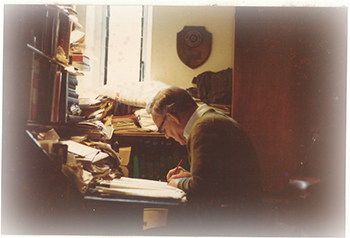
Image Courtesy of the Cumming family Gibraltar
Mr Cumming held the post until 1985, and during his tenure the nature of the office changed from that originally called for.
The primary duty of sorting out and listing documents remained largely undone, the reason given for this being
lack of suitable storage space. However, a Staff inspection report in 1980 attributed the main factor for the
delay to the way that post had move away from its original purpose of sorting and listing to work of a
broadly advisory nature such as providing assistance to researchers,
students and other persons seeking historical information about Gibraltar.
Thus most of the loose papers and some bound volumes remained in the store at Naval Hospital Hill
gathering more and more dust! On a more positive side, material stored at the City Hall,
relating to the Board of Sanitary Commissioners and the City Council of Gibraltar were added to the
collection at the Convent Yard. These very important documents had at one stage been
subjected to flooding and bad storage conditions. Other important volumes,
scattered in various offices, were also gathered together and housed in the Convent Yard premises.
The same staff inspection report concluded with the recommendation that the post should be withdrawn,
custody of the records and responsibility for answering enquiries and similar work being passed
to the Museum Curator/Archivist.
It seems that this report was not submitted and matters remained as before until 1982 when consideration
was given to the matter of
Mr. Cumming’s retirement and the appointment of a successor.
Once again the idea that the archives should come
under the Museum Curator was mooted, though it was also questioned whether he would have the spare capacity to
take over additional work. Another suggestion was that the Mackintosh Hall Librarian might assist in the matter of cataloguing.
The issue dragged on for a further two years.
In September, 1984, the post was advertised with a new job description which encompassed a wide-ranging set of duties.
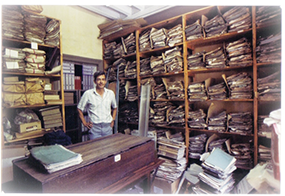
Mr. T.J. Finlayson, a History graduate with twenty three years teaching experience, was appointed to the post in September, 1985.
Since the the Archivist turned his attention to the mammoth tasks of sorting out and listing the volumes in the Convent Yard premises,
wading through thousands of loose papers in the Naval Hospital store
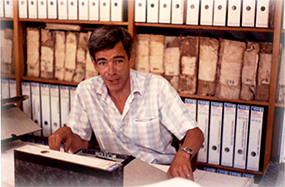
Tommy J Finlayson Gibraltar Archivist 1984-2004
conducting some research into the history of Gibraltar,
and at the same time attempting to deal with enquiries which come into the office from time to time,
both from local sources and from overseas.
In 2004 Mr. Finlayson retired and, the post was then taken up by Mr. Dennis Beiso who held the post until 2013
when he became the Chief Executive Officer of the Gibraltar Football Association.
On 11th February 2014 Mr. Anthony W Pitaluga an Information Technology & Computing graduate was appointed Gibraltar Government Archivist.
This appointment is in line with the policy of the Government to digitise the archives
and to make information more accessible and available on-line to the general public.
History of the Gibraltar National Archives researched by T J Finlayson - erstwhile Archivist - Gibraltar Government Archives
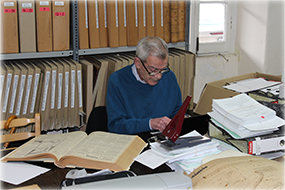
Tommy still going strong. Working at GNA Feb 2015
Digitised by A W Pitaluga - Archivist - Gibraltar National Archives

Images: Gerard Wood GNA Conservation Officer
History of the Gibraltar National Archives PDF Version